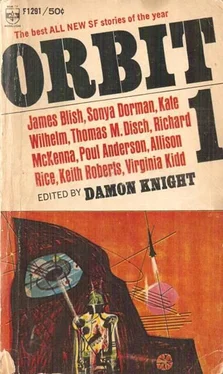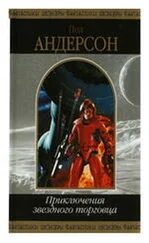Пол Андерсон - Orbit 1
Здесь есть возможность читать онлайн «Пол Андерсон - Orbit 1» весь текст электронной книги совершенно бесплатно (целиком полную версию без сокращений). В некоторых случаях можно слушать аудио, скачать через торрент в формате fb2 и присутствует краткое содержание. Год выпуска: 1966, Жанр: Фантастика и фэнтези, на английском языке. Описание произведения, (предисловие) а так же отзывы посетителей доступны на портале библиотеки ЛибКат.
- Название:Orbit 1
- Автор:
- Жанр:
- Год:1966
- ISBN:нет данных
- Рейтинг книги:4 / 5. Голосов: 1
-
Избранное:Добавить в избранное
- Отзывы:
-
Ваша оценка:
- 80
- 1
- 2
- 3
- 4
- 5
Orbit 1: краткое содержание, описание и аннотация
Предлагаем к чтению аннотацию, описание, краткое содержание или предисловие (зависит от того, что написал сам автор книги «Orbit 1»). Если вы не нашли необходимую информацию о книге — напишите в комментариях, мы постараемся отыскать её.
Orbit 1 — читать онлайн бесплатно полную книгу (весь текст) целиком
Ниже представлен текст книги, разбитый по страницам. Система сохранения места последней прочитанной страницы, позволяет с удобством читать онлайн бесплатно книгу «Orbit 1», без необходимости каждый раз заново искать на чём Вы остановились. Поставьте закладку, и сможете в любой момент перейти на страницу, на которой закончили чтение.
Интервал:
Закладка:
No comparison with the aliens can justifiably be made, inasmuch as there are as yet no young to be observed in this group, nor is it likely that any will appear. It is, perhaps, however, indicative, that, while the males wear a species of body harness which covers and perhaps exaggerates the reproductive area, the females do not, and are most easily identified by the lack of protective covering; the pouch, being unoccupied, is virtually invisible. The civ, Mager, who claims to be in actual communication with the Leloc, submits that the word for the female’s pouch is one and the same as the word for the male body harness — but inclusion here of this alleged information does not constitute endorsement.
In Earthly marsupials, the offspring do tend to be more and more immature at birth, and to become ectoparasites thereafter, allowing a certain comparison with the human case. Marsupials as we know them however, all expel their cubs early — sometimes without seeming to realize that they have abandoned them. Only the young which survive such cavalier treatment remain with the herd.
If it is true, as it is claimed, that the aliens have previously visited Earth, and established a colony at that time, it is possible that the present visit of the aliens is meant to reclaim the colonists; such an interpretation is put, by one of us, upon Mager’s claim that the Leloc “say” they desire only to “gather up those dropped.”
We would like, however, to direct Liaison’s attention to the fact that marsupials have lived upon the Earth for at least 125 million years, and that the Leloc cannot therefore be related to any local fauna in any conceivable way. Any other suggestion is irresponsible, in the opinion of the majority, and totally without foundation in the facts.
LIAISON
Leloc — II—45:057: Propulsion
The conclusions of the group leader on propulsion are as follows: (1) the Leloc drive is inoperable, and probably wholly imaginary; and, (2) if it functions as deduced, the Leloc are hopelessly lost.
Conclusion One is obviously untrue, since the Leloc are here and their drive therefore functions. Nevertheless we begin with it to emphasize that our analysis of how it operates is derived from indirect evidence and hence cannot be trusted; thus, the second conclusion is also untrustworthy.
Relatively firm evidence supplied by the Group on Symbols and Signs places the point of origin of the Leloc somewhere within a powerful radio-emitting blue cluster estimated to be at the edge of the galactic halo, in Ursa Minor. Since the physical nature of this object is in doubt, there is some dispute as to how to interpret its red-shift measurements. The distances involved are immense and could not have been traversed by any vessel imaginable to us in anything under 125 million years. These mortal animals, however, have made this journey in a single generation, apparently in less than six months.
The S & S Group has also noted that all code and other marks of the Leloc are rigidly bound to an underlying metrical frame, sometimes drawn in, but most often only implicit, which most closely resembles our own tic-tac-toe sign subjected to certain highly rhythmic distortions. The projective geometry of this frame is quite obviously non-Euclidean, though since our only samples of it are brief curves in only two dimensions, we have found it impossible to determine the four-or-more-dimensional curvature which is implied.
Third, what little we have been able to see of Leloc instruments suggests that these animals are acutely sensitive to parts of the electromagnetic spectrum which can be only pointer readings to human eyes. Their grand navigation grid, for example — to choose only the largest and most obvious of the tools aboard their ship — involves at least four coordinates and may be found to be unreadable except in Hilbert space; yet no overt grid network is visible in it, and it seems to be read by very small differences in the colors and absolute magnitudes of the token stars it shows. These, incidentally, became visible to us only through Dr. Minowski’s diffraction filters after long examination.
The engines of the Leloc ship are small, simple and beyond any present analysis. They appear to consume very little power. However, everything aboard the ship appears to be economical of power. S & S reports that the Leloc appear to be naturally conservative, and there is as yet no suggestion that these animals would undertake an expedition of this duration distance with less than a reasonable safety factor. It is reluctantly concluded that the power available is greater, by an unknown order of magnitude, than any need foreseen by the Leloc; hence these engines must indeed operate upon this very small power flow. (The emergency which the Leloc confront at present may or may not be beyond their resources. On this point our evidence is virtually zero; our guess is that they do not recognize the emergency for what it is.)
These bits and pieces of fact and assumption are most unsatisfactory, but we have been forced to use them because there are no others; experiment is impossible in a unique situation. From them we draw the following description of the Leloc drive:
The (unknown) principle acts directly upon the metrical frame of spacetime — the multidimensional web-work which Newton once called “absolute space,” and which has since been redefined in many other ways. Assuming that this is possible, one can see that such a drive would have many advantages which, in fact, the Leloc drive actually possesses. It would require almost no expenditure of energy, because it would work as simply as a lever: the direction in which such a machine would travel would be a vector or resultant pried out of the fundamental tension exerted by the metrical frame in keeping itself in existence, and from which cauldron of energy the ship need take only a glancing blow to gain all the power it could possibly need. Second, since matter warps the metrical frame in its immediate vicinity, large bodies such as suns and planets need not be watched for at high velocities; the drive could be set to avoid them automatically. Third, such a drive would so recreate the metrical frame as to maintain it in near-normal condition in the vicinity of the ship, so that in that vicinity the ship need never approach the speed of light though the surrounding spacetime may be traversing the frame at many multiples of light speed. (See Appendix IV, “Pseudo-Lorentz Invariance as a Turbine Function.”)
This brings us to Conclusion II, which assumes that our analysis of the Leloc drive is correct — a very dubious precondition.
Since Leloc “writing” and symbology are derived from and refer to a non-Euclidean geometry, and since the Leloc can see and act upon events in Hilbert space which they seem to receive directly as sense data rather than indirectly as meter readings, we have no present choice but to assume that their drive is not a late product of their technology, but is actually exceedingly primitive— perhaps the first of all Leloc space drives. If this is true, then the first arrival here of the Leloc would have given them no reason to suspect the divagations from experience implicit in the theory until such errors became patent to their senses; they must have been as confident of their “common-sense” non-Euclideanism as we once were of Euclid. Local trial flights, furthermore, would not reveal the rather small errors involved. In particular, only a long flight would disclose that cruising world lines from one star to another accumulates substantial errors in time —in this instance, well more than 100 million years.
Our second conclusion, therefore, is that cruising world lines must be perilously close to being a random procedure. Every atom has a world line of its own, and, though the world line of a large body like a sun should not be difficult to distinguish from the background “noise” of smaller event threads over very short distances, interstellar travel involves so large a volume of spacetime that precise arrivals and departures are out of the question. The Leloc expedition apparently decided to return to Earth for reasons unknown in a mere six months (subjective time) after their original landing, but arrived here at least 100 million years later. Similarly, the expedition may home on its own sun in Ursa Minor and voyage a seeming two or three years but arrive there as much as 80 to 100 million years before —or after! — their initial departure.
Читать дальшеИнтервал:
Закладка:
Похожие книги на «Orbit 1»
Представляем Вашему вниманию похожие книги на «Orbit 1» списком для выбора. Мы отобрали схожую по названию и смыслу литературу в надежде предоставить читателям больше вариантов отыскать новые, интересные, ещё непрочитанные произведения.
Обсуждение, отзывы о книге «Orbit 1» и просто собственные мнения читателей. Оставьте ваши комментарии, напишите, что Вы думаете о произведении, его смысле или главных героях. Укажите что конкретно понравилось, а что нет, и почему Вы так считаете.












